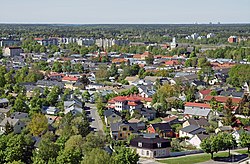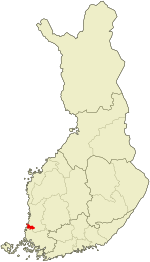Rauma, Finland
|
Rauma Raumo |
||
|---|---|---|
| Town | ||
| Rauman kaupunki | ||

Rauma in May 2012
|
||
|
||
| Motto: Gyl Raum o ain Raum | ||
 Location of Rauma in Finland |
||
| Coordinates: 61°08′N 021°30′E / 61.133°N 21.500°ECoordinates: 61°08′N 021°30′E / 61.133°N 21.500°E | ||
| Country |
|
|
| Region | Satakunta | |
| Sub-region | Rauma sub-region | |
| Charter | 1442-04-17 | |
| Government | ||
| • Town manager | Kari Koski | |
| Area (2011-01-01) | ||
| • Total | 1,110.12 km2 (428.62 sq mi) | |
| • Land | 495.64 km2 (191.37 sq mi) | |
| • Water | 614.48 km2 (237.25 sq mi) | |
| Area rank | 102nd largest in Finland | |
| Population (2016-03-31) | ||
| • Total | 39,697 | |
| • Rank | 26th largest in Finland | |
| • Density | 80.09/km2 (207.4/sq mi) | |
| • Demonym | Raumalainen (Finnish), Raumlaine (Dialect) | |
| Population by native language | ||
| • Finnish | 98.2% (official) | |
| • Swedish | 0.4% | |
| • Others | 1.4% | |
| Population by age | ||
| • 0 to 14 | 15.2% | |
| • 15 to 64 | 65.8% | |
| • 65 or older | 18.9% | |
| Time zone | EET (UTC+2) | |
| • Summer (DST) | EEST (UTC+3) | |
| Municipal tax rate | 18% | |
| Climate | Dfb | |
| Website | www.rauma.fi | |
Rauma (Finnish pronunciation: [ˈrɑumɑ], Swedish: Raumo) is a town and municipality of ca. 39,700 (31 March 2016 ) inhabitants on the west coast of Finland, 92 kilometres (57 mi) north of Turku, and 50 kilometres (31 mi) south of Pori. Granted town privileges on 17 April 1442 (then under the rule of Sweden), Rauma is known for its paper and maritime industry, high quality lace (since the 18th century) and the old wooden architecture of its centre (Old Rauma, Vanha Rauma), which is a Unesco world heritage site.
In the 14th century, before being declared as a town, Rauma had a Franciscan monastery and a Catholic church. In 1550, the townsmen of Rauma were ordered to relocate to Helsinki, but this was successfully countered and Rauma could continue its growth.
Practically the whole wooden town of Rauma was devastated in the fires of 1640 and 1682. The wooden city centre, which is how large the town was until 1809, has approximately 600 wooden buildings. The neo-renaissance style of many of the houses is a result of prosperity brought on by seafaring. In 1897 Rauma had the largest fleet of sailing boats in Finland, totalling 57 vessels. Goods were mainly exported to Germany, and the Baltic states. In the 1890s, Rauma got a teacher's college (a 'seminar'), which was later annexed to the University of Turku. A part of the department of education still exists in Rauma.
...
Wikipedia

